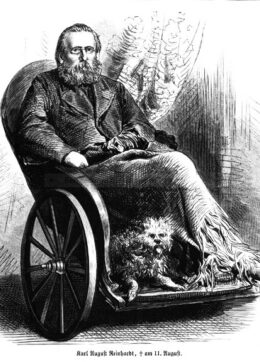
Printed
8 pages
Author(s)
Kasperl und der Tod
In 1852, Carl Reinhardt published a series of plays for Kasperl in addition to the illustrated plates which he was publishing at the time in the Münchner Bilderbogen. The text, whose authorship remains uncertain, serves as a caption to a graphic work which made Reinhardt the father of comics in Germany; it was certainly not meant to be staged. Even so, these short sketches reproduce typical scenes and routines of the repertoire for glove-puppets of the time, with the characters being drawn most of the time from the waist up. In this play, Kasperl faces the character of Death concluding a cycle which the author ends with an epilogue: Kasperl macht Schluß (Kasperl ends). In it, the hero talks about the happiness of having fought against Christians and Turks, and of having won over death and the devil. He announces his plan of going out to drink beer, and asks the audience for generous tips. This epilogue, destined for the “Gentlemen” (meine Herren), clearly indicates that Reinhardt does not consider his “Kasperl theatre” to be the children theatre that it will later become with Joseph Leonhardt Schmid’s (also known as “Papa” Schmid) institution in Munich. Kasperl addresses the mainly male readers of the satirical newspapers in which Reinhardt published his illustrations.
The hero triumphs over death
Kasperl drags on stage the corpse of the devil murdered in Kasperl und der Teufel, and, to get rid of it, throws it out of the hand-puppet booth. His wife suddenly tells him that Death is coming before running away. Death tells Kasperl that it is time to die, but he answers that he does not have time for that. As Death insists, he asks to go and kiss his dear wife one last time: he comes back with a stick and, letting Death go before him, he strikes the skeleton to pieces with a great blow in its back. He leaves and gently sings: everyone now celebrates Kasperl for having defeated Death.
Publications and translations
Carl Reinhardt, Das wahrhaftige Kasperltheater, Münchner Bilderbogen, 1852
Louis Lemercier de Neuville, Histoire anecdotique du théâtre de marionnettes. Paris: Calmann-Lévy, 1892, p.67-69.
(French)
